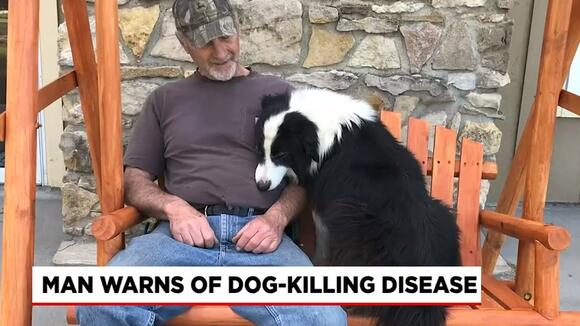 |
| A Border ColliePhoto byAsher LeggonUnsplash |
KCTV News 5 reported that Paul Miller from Pleasant Hill is still grieving over his best friend, a border collie named Boomer. His dog was acting sluggish and vomiting, but they were not able to save Boomer.
The veterinarian diagnosed Boomer with canine dysautonomia (CD), a dog illness that is mostly seen in the Midwest United States, and most US cases are seen in Kansas City. This disease is linked to bacteria found in dirt and is often misdiagnosed in dogs. (Source: KCTV News 5)
Paul said:
“Well, he was just a constant companion,” said Miller. “He was a Border Collie. They tend to be very loyal to one person. We have a farm and he went with me to do chores and check cows and everything.” -Paul Miller, lost his dog Boomer to CD (Source: KCTV News 5)
Paul and Boomer had some great times together and can be seen in the picture below.
 |
| Paul Miller and BoomerPhoto byKCTV 5 News |
Paul said:
“I’m 70 years old and it’s very emotional for me,” Miller said while reminiscing. “It doesn’t matter what age you are. If you get attached to an animal, it’s part of your life. It’s hard. I just want people to be aware of this disease.” -Paul Miller, lost his dog Boomer to CD (Source: KCTV News 5)
Most importantly, Paul wants others to be aware of this disease.
The American Animal Hospital Association (AAHA) on Canine Dysautonomia (CD)
The American Animal Hospital Association (AAHA) reported that the first diagnosis of CD took place in the UK in 1983, and the second case diagnosis was found in Wyoming in 1991. "In the US, it's mostly in rural, midwestern states such as Kansas, Missouri, and Wyoming; that it’s more prevalent in dogs who spend more than half their time outside; and that it seems to affect younger dogs—with the average age being three years old at the time of diagnosis."
One reason that we don't see many cases of it, is because "the disease is frequently misdiagnosed and treated as a respiratory or gastrointestinal condition due to the appearance of the initial symptoms." Source: AAHA
Those symptoms include:
- Decreased tear production
- Diarrhea
- Dilated pupils
- Straining and/or Difficulty urinating or defecating
- Distended bladder
- Low or absent anal tone
- Thick nasal discharge
- Protrusion of third eyelid
Source: AAHA
Some of these symptoms do sound strange, but they were actually reported by AAHA.
An Early Diagnosis Gives the Best Chance of Survival
It is important that if a person thinks their dog has canine dysautonomia, the earlier it is diagnosed, the better chances their dog has.
Researcher Brant Schumaker, Ph.D., at Wyoming State Veterinary Laboratory says that this is an "extremely serious disease with a 92% mortality rate." Source: AAHA
There is a Facebook page for Canine Dysautonomia Awareness to help educate the public.
Please share this information on social media so others can be informed of this uncommon dog disease.
Sources
Canine Dysautonomia Awareness Facebook page
Jackson, Josh. "'Man warns of strange, uncommon disease that can kill dogs." KCTV 5 News. 4 January 2023.
McReynolds, Tony. "Canine dysautonomia is killing dogs and no one knows why." AAHA.org. 21 October 2019.
No comments:
Post a Comment